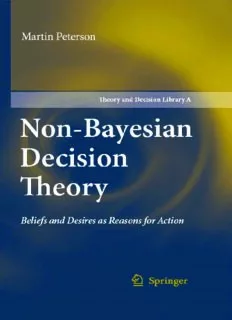Table Of ContentNON-BAYESIAN DECISION THEORY
BELIEFS AND DESIRES AS REASONS FOR ACTION
THEORY AND DECISION LIBRARY
General Editor: Julian Nida-Rümelin (Universita¨tMu¨nchen)
Series A:Philosophy and Methodology of the Social Sciences
Series B:Mathematical and Statistical Methods
Series C:Game Theory,Mathematical Programming and Operations Research
SERIES A:PHILOSOPHY AND METHODOLOGY
OF THE SOCIAL SCIENCES
VOLUME 44
Assistant Editor: Martin Rechenauer (Universita¨tMu¨nchen)
Editorial Board:Raymond Boudon (Paris),Mario Bunge (Montréal),Isaac Levi (New York),
Richard V.Mattessich (Vancouver),Bertrand Munier (Cachan),Amartya K.Sen (Cambridge),
Brian Skyrms (Irvine),Wolfgang Spohn (Konstanz)
Scope: This series deals with the foundations,the general methodology and the criteria,
goals and purpose ofthe social sciences.The emphasis in the Series A will be on well-argued,
thoroughly analytical rather than advanced mathematical treatments. In this context,
particular attention will be paid to game and decision theory and general philosophical topics
from mathematics,psychology and economics,such as game theory,voting and welfare
theory,with applications to political science,sociology,law and ethics.
For other titles published in this series, go to
www.springer.com/series/6616
Martin Peterson
NON-BAYESIAN
DECISION THEORY
Beliefs and Desires as Reasons
for Action
ABC
Martin Peterson
Department of History
and Philosophy of Science
University of Cambridge
Cambridge, CB2 3RH
ISBN978-1-4020-8698-4 e-ISBN978-1-4020-8699-1
LibraryofCongressControlNumber:2008928678
(cid:176)c 2008SpringerScience+BusinessMediaB.V.
Nopartofthisworkmaybereproduced,storedinaretrievalsystem,ortransmittedinanyform
orbyanymeans,electronic,mechanical,photocopying,micro(cid:2)lming,recordingorotherwise,with-
outwrittenpermissionfromthePublisher,withtheexceptionofanymaterialsuppliedspecically
for the purpose of being entered and executed on a computer system, for exclusive use by
thepurchaserofthework.
Printedonacid-freepaper
9 8 7 6 5 4 3 2 1
springer.com
Preface
For quite some time, philosophers, economists, and statisticians have endorsed a
view onrationalchoice known asBayesianism. Theworkonthisbook hasgrown
outofafeelingthattheBayesianviewhascometodominatetheacademiccommu-
nitytosuchanextentthatalternative,non-Bayesianpositionsareseldomextensively
researched.Needlesstosay,Ithinkthisisapity.Non-Bayesianpositionsdeserveto
beexaminedwithmuchgreatercare,andthepresentworkisanattempttodefend
what I believe to be a coherent and reasonably detailed non-Bayesian account of
decisiontheory.
The main thesis I defend can be summarised as follows. Rational agents max-
imisesubjectiveexpectedutility,butcontrarytowhatisclaimedbyBayesians,util-
ity and subjective probability should not be defined in terms of preferences over
uncertain prospects. On the contrary, rational decision makers need only consider
preferencesovercertainoutcomes.Itwillbeshownthatutilityandprobabilityfunc-
tionsderivedinanon-Bayesianmannercanbeusedforgeneratingpreferencesover
uncertain prospects, that support the principle of maximising subjective expected
utility.Tosomeextent,thisnon-Bayesianviewgivesanaccountofwhatmodernde-
cisiontheorycouldhavebeenlike,haddecisiontheoristsnotenteredtheBayesian
pathdiscoveredbyRamsey,deFinetti,Savage,andothers.
Iwillnotdiscussallpreviousnon-Bayesianpositionspresentedintheliterature.
Somedemarcationlinesbetweenalternativenon-Bayesianpositionswillsimplybe
takenforgranted.Mostnotably,IassumethatsomeversionoftheHumeanbelief-
desire model of action is correct. Decision theories that seek to derive normative
conclusionsfromotherentitiesthanbeliefsanddesires(suchasobjectivefrequen-
cies or propensities) will hardly be discussed at all. By sticking to the traditional
belief-desire model of action, I hope to retain as much as possible of what I think
arethegoodfeaturesoftheBayesianapproach,withoutbeingcommittedtoaccept-
ingthelessattractiveparts.
Thepresentworkismainlyconcernedwithphilosophicalissuesindecisionthe-
ory.Althoughanumber oftechnical resultsarepresented, thefocusissetoncon-
ceptualandnormativeproblems.Allproofsappearintheappendix.Onlythemost
elementarykindsofdecisionproblemsareconsidered,thatis,singledecisionstaken
v
vi Preface
by a single agent at a given point in time. More complicated decisions problems
inevitably require a more complex technical apparatus, but the philosophical sig-
nificance of those problems seldom stand in proportion to the technical apparatus
requiredforhandlingthem.
***
TheopportunitytowritethisbookarosewhenIacceptedaresearchpositioninthe
DepartmentofHistoryandPhilosophyofScienceattheUniversityofCambridge.
Iwishtothankallmycolleaguesfortheirsupportandforcreatingsuchastimulating
researchatmosphereinthedepartment.Thebookis,however,basedonanumberof
articlesIhavewrittenoverthepastfiveyearswhileworkingattheRoyalInstitute
of Technology in Stockholm and at Lulea University of Technology, so I am also
deeplyindebtedtomycollegesthere.Inparticular,IwouldliketothankSvenOve
Hanssonforcommentsandhelpfulcriticismofnearlyallviewsandargumentsput
forwardinthisbook.Withouthisabilitytoquicklyandpreciselyidentifytheweak
partofanargument,thisbookcouldneverhavebeencompleted.Iwouldalsoliketo
thankNicholasEspinozaforstimulatingdiscussionsonindeterminatepreferences.
Alargenumberofpeoplehavegiveninvaluablecommentsonindividualchapters
or the papers on which they are based. In particular, I would like to thank Barbro
Bjo¨rkman, Anna Bjurman, Sven Danielsson, John Cantwell, Johan Gustafsson,
Stephen John, Peter Kesting, Karsten Klint Jensen, Duncan Luce, Wlodek
Rabionowicz, Per Sandin, Tor Sandqvist, Nils-Eric Sahlin, and Teddy Seidenfeld.
My work on this project has been partially funded by a generous grant from the
SwedishRescueServicesAgency.
Chapters1,2,5and6arebasedonpreviouslyunpublishedmaterial.Chapter3is
basedon,butnotidenticalto,Peterson(2003a),(2003b),and(2004a)andPeterson
andHansson(2004).MostofChapter4istakenfromPeterson(2006a)andEspinoza
andPeterson(2006).IwishtothankEspinozaandHanssonforallowingmetoin-
clude material from our joint papers. The formal results in Chapter 7 originally
appearedinPeterson(2002a)and(2004b).Chapter8isbasedonPeterson(2002b),
(2006b), and (2006c). I thank the editors of the journals in which the papers ap-
pearedforlettingmereproducesubstantialsectionsofthemhere.
Idedicatethisbooktomychildren,LouiseandHenrik.
Cambridge,March2008
MartinPeterson
Contents
1 Introduction................................................... 1
1.1 Thesubjectivenon-Bayesianapproach......................... 4
1.2 Acriterionofrationalityforidealagents ....................... 5
1.3 Basicconcepts............................................. 7
1.4 Preview................................................... 11
2 Bayesiandecisiontheory ........................................ 13
2.1 Thebasicidea ............................................. 14
2.2 Fromobjectivetosubjectiveprobability........................ 17
2.3 Thepurelysubjectiveapproach ............................... 20
2.4 Thepropositionalapproach .................................. 23
2.5 DoBayesiansputthecartbeforethehorse?..................... 26
3 Choosingwhattodecide ........................................ 31
3.1 Transformativeandeffectiverulesdefined...................... 33
3.2 Acomparisonstructureforformalrepresentations ............... 36
3.3 Anaxiomaticanalysisoftransformativedecisionrules ........... 37
3.4 Strongversusweakmonotonicity ............................. 40
3.5 Twonotionsofpermutability................................. 43
3.6 Moreoniterativity.......................................... 48
3.7 Acyclicity................................................. 52
3.8 Rivalrepresentations........................................ 53
4 Indeterminatepreferences ...................................... 61
4.1 Previousaccountsofpreferentialindeterminacy ................. 62
4.2 Whatisapreference? ....................................... 64
4.3 Introductiontotheprobabilistictheory......................... 68
4.4 Theprobabilisticanalysisofpreference ........................ 69
4.5 Reflexivity,symmetry,andtransitivity ......................... 70
4.6 Thechoiceaxiomisnotuniversallyvalid....................... 73
4.7 SpohnandLevionself-predictingprobabilities ................. 74
vii
viii Contents
4.8 Furtherremarksonindeterminatepreferences................... 79
5 Utility......................................................... 81
5.1 Theclassicaltheory......................................... 82
5.2 Theprobabilistictheory ..................................... 87
5.3 Amodifiedversionoftheprobabilistictheory................... 89
5.4 Candesiresbereducedtobeliefs?............................. 91
5.5 Second-orderpreferences.................................... 92
6 Subjectiveprobability .......................................... 95
6.1 Whynotobjectiveprobability? ............................... 96
6.2 WhynotBayesiansubjectiveprobability? ...................... 99
6.3 Non-Bayesiansubjectiveprobability...........................102
6.4 Subjectivenon-Bayesianprobabilityandhorseracelotteries.......105
6.5 Concludingremarks ........................................107
7 Expectedutility ................................................109
7.1 FromPascaltoAllais .......................................110
7.2 Preambletothenewaxiomatisations ..........................112
7.3 Therule-basedaxiomatisation................................112
7.4 Theact-basedaxiomatisation.................................118
7.5 TheAllaisparadox .........................................120
7.6 Theindependenceaxiomvs.thetrade-offprinciple ..............123
8 Riskaversion ..................................................127
8.1 BeyondthePratt-Arrowconcept ..............................128
8.2 Thefirstimpossibilitytheorem ...............................130
8.3 Thesecondimpossibilitytheorem.............................133
8.4 Theprecautionaryprinciple ..................................134
8.5 Thefourthimpossibilitytheorem .............................138
8.6 Riskaversionasanepistemicconcept? ........................140
AppendixA: Proofs ...............................................143
References.........................................................163
Index .............................................................169
Chapter 1
Introduction
Awhilebackabeautifulwoman,whomIquiteliked,askedmetomarryher.Iwas
stunned.Marriage?Now?Itistooearly!Ihavenoteventurnedforty!However,for
onereasonoranotherIdecidednottosharemyspontaneousreactionwithher.Isaid
Ifeltoverwhelmedbythisflattering,althoughratherunexpectedproposal,andthat
I needed some time to think it over. At dawn the following day I sneaked out and
raced to the university library. I borrowed all the books I could find on decision
theory.Laterthesameafternoon,afterhavinglearnedwhatmoderndecisiontheory
isallabout,Istillhadnocluehowtoanswerthelady.
Most decision theorists agree that there is nothing special about marriage
proposals–atleastnotfromatheoreticalpointofview.Asuccessfuldecisiontheory
should be equally applicable to choosing a partner as to decisions on financial in-
vestments or environmental management, or in issues related to health and safety.
Thisisbecausedecisiontheoristsseektomakeaperfectlygeneralclaimaboutra-
tional decision making. According to the overwhelming majority of scholars, the
aimofdecisiontheoryistocharacterisewhatanagentoughttodo,givenhisorher
presentbeliefsanddesires.Whatkindofissuethesebeliefsanddesiresareabout,
isirrelevant.
The literature on decision theory is huge and ever-expanding; it is difficult to
drawacomprehensivemapofthefield.Thepresentbookisconcernedwithasingle,
well-definedproblemindecisiontheory,viz.thecontroversyoverBayesianismand
non-Bayesianism.Theessenceofthedisputeisthefollowing.Bayesiansthinkitis
enoughthatrationalagentsbehaveasif theymaximisesubjectiveexpectedutility,
whereas non-Bayesians believe one should choose an act over another because its
subjective expected utility is optimal. (The subjective expected utility of an act is
thesumofutilitiesofallitspossibleoutcomes,weightedbytheagent’ssubjective
probabilityofeachoutcome.)Forseveraldecades,Bayesianviewshavedominated
thefield.TheaimofthisbookistochallengetheBayesianapproachandshowthat
thereisaviablenon-Bayesianalternative.
The difference between the two approaches can be illustrated in the marriage
example. There are two alternatives, marriage or no marriage. Marriage may lead
to roughly two possible outcomes, bliss or divorce. If the proposal is rejected, the
1
Description:This book aims to present an account of rational choice from a non-Bayesian point of view. Rational agents maximize subjective expected utility, but contrary to what is claimed by Bayesians, the author argues that utility and subjective probability should not be defined in terms of preferences over

